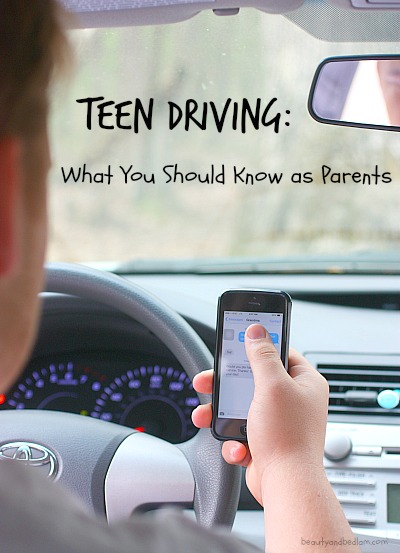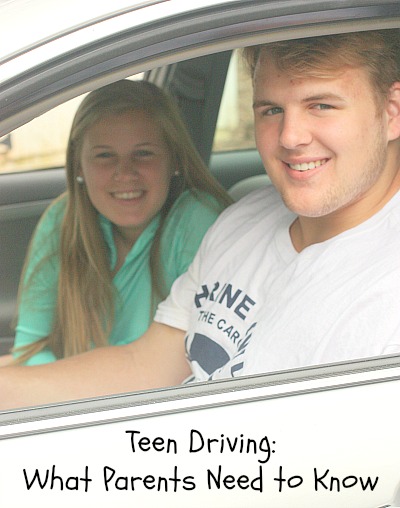
Throughout the car, the music boomed loudly. Our teen driver leaned over, grabbed his ipod while driving and started scrolling through looking for a new song from his play list.
Shocked, I barked from the passenger seat, “What do you think you are doing?
“What? I am just putting on a new song,” my larger than life son responded.
In his mind, he was updating his play list. In my mind, the accident statistics that result from distracted driving erupted in my mind.
Right then, a harsh reality sank close to home. We have three drivers in the age bracket of 16 – 20, who represent the highest average annual crash and traffic violation rates of any other age group. Our daughter begins driver’s education in a few months and with four young drivers in one household, you can be guaranteed I’ve done my homework on teen safety, driving habits, as well as figuring out “How in the world do we pay for all this?”
Let me take you step by step through our thought process as we’ve experienced three teen drivers in three years.
First, Give Yourself Permission to Say “No” on Their Birthday.
Somehow the lines have become blurred with this “magic” age and we’ve confused a “legal age” for a responsible age. As a parent, you understand your child best, but have you taken a hard look at if this child is ready to drive or are you assuming it’s a right of passage? This decision can not be based on convenience, but rather on their maturity level. Begin this conversation early.
Be heart honest as you ask yourself the hard questions.
Do they tackle chores well at home? How do they respond to authority? Are they cautious or indecisive? Do you think they can practice self control when it comes to texting and driving? Are they at an age where social media rules them? Are they checking their phone constantly?
All these may be red flags when it comes to driving. A large majority of 16 year old teens have not reached a maturity level where they should be responsible for other people’s lives, let alone their own.
After much deliberation, we’ve delayed drivers licenses with each of our children, but they knew that decision over a year in advance. It was not an impulsive decision, and we took many factors into consideration. The safety statistics and cost of insurance premiums for teen boys led the way. What I learned through the local AllState insurance agent confirmed our decision.
According to a study in 2012 by the Insurance Institute for Highway Safety, teenagers drive less than all but the oldest people, but their numbers of crashes and crash deaths are disproportionately high. In the United States, the fatal crash rate per mile driven for 16-19 year-olds is nearly 3 times the rate for drivers ages 20 and over. Risk is highest at ages 16-17. In fact, the fatal crash rate per mile driven is nearly twice as high for 16-17 year-olds as it is for 18-19 year-olds. Statistically, giving teens an extra year of driving makes a big difference.
Distracted Driving Kills: Startling Statistics
Most teens do not comprehend the very serious dangers that result from distracted driving. Our 17 year old is one of the few teens that does not have a cell phone, so the threat of texting and driving is not yet a concern, but whether it’s changing the radio station, putting on mascara or texting, distracted driving kills.
Teens hear over and over, “Don’t text and drive,” but they aren’t listening. The statistics speak for themselves and they all think that the accident on the news will not happen to them.
How’s this for a harsh reality?
Texting while driving makes you 23 times more likely to crash based on the statistics from the National Highway Transportation Safety Administration. 78% of teens and young adults say they have read a text message while driving and 48% of kids from ages 12 to 17 report being in a car when the driver was texting and that’s just from those surveyed who actually admitted it.
In a 2012, the U.S. Department of Transportation (DOT) report about Teens and Teen Drivers, 2,228 teenagers died in motor vehicle accidents with 11% of those teens reported as being distracted. I can only imagine that this statistic has risen as cell phones become common place for every teen.
But my real concerns stems from the fact that 77% of teens feel very or somewhat confident that they can safely text and drive, yet 10% of teen drivers routinely drive outside of their lanes. At this age, they are so sure of their immortality, so even statistics may not get their attention, but this analogy will.
Quite possibly, a real life experiment may be necessary to impress upon your kids the dangers of texting and driving.
Take them to their school’s football field and walk them to the end zone. View the field, have them run it to understand just how far of a distance 100 yards covers. Dare them to drive the length of this field blind folded.
Would they do it? Of course, they’d say “No,” but that is exactly what they do every time they send a text.
In the five seconds it takes to send an average text, the vehicle has covered more than the length of a football field (if driving at highway speed.)
Repeat that fact to them a few times. Sending one text is comparable to driving the length of a football field blind folded. Accidents happen that quickly and as parents, I am sure we can all attest to that fact. Just last week, a car slammed on its brakes while I was looking in my rear view mirror. Fortunately, I stopped in time, but had I been looking down, I would have slammed into him.
Have Your Child Sign a Pledge
Talk through the ramifications of cell phone usage and create a family pledge. Outline consequences if trust is broken in this area. Even for me, it’s a temptation to grab my phone while driving, so I’ve given my kids 100% permission to call me out any time they see it.
Determine where the phone will be when driving. There is NOTHING that is important enough that they can not wait a few minutes to check their messages. Yet with this instant society we’ve created , they always feel a sense of urgency. A few suggestions might be to put their phone in the trunk or back seat while driving thus removing the temptation and turn the phone off completely so as not to be distracted by the incoming “pings.”
What Happens if My Child Gets a Ticket?
Unfortunately, I will speak from too much parental experience. If you are not versed in traffic laws of your area, my first bit of advice is to hire a lawyer. As soon as that routine speeding ticket gets entered, your mail box will be flooded with “service offers.” While it’s what traffic attorneys do, it’s also a valuable service. We paid a very nominal fee, the attorney showed up in our place, filed the specific papers and took care of everything else. Depending on your county, you may or may not have to pay the court fee. Many cities wave the fee if the ticket is reduced. Do not just pay off a ticket and keep points on your record.
Points = insurance premium hikes that will cost you exponentially in the long run.
Working with the courts and/or your own attorney can help keep points off the driver’s record. Early on, the ticket can be reduced from a moving violation to simply a fine. Also, some states offer an on-line defensive driving course to first time offenders, at a cost, that will take the points and the ticket off the drivers’ record.
How Can I Save on their Insurance Premiums?
With our auto premiums at an all time high due to so many young drivers, I recently asked the Allstate agent if there were any alternative ways to save on our insurance.
He responded with a few things that I wish I’d known earlier, so hopefully, they will help you. When putting a young driver on a policy, the best thing to do is have an itemized discussion with your agent. Your agent can make sure that the teen is placed on the right vehicle such as an older car with the least amount of coverages and the lowest premium impact. Determine if it makes economic sense to remove collision insurance.
Allstate supports a “Teen Smart Program” – parents can buy a piece of software and the teen takes an online class. Upon completion, a 15% discount is implemented on the teenager’s vehicle.
Allstate offers a “Good Student Discount” to all teens (up to age 21) who carry a GPA of 3.0 or better in high school and college. Also, discuss making the teen a “Secondary Operator” on the vehicle if the student is away at college or in the service and the car did not go with them. These last two are huge insentives for us to take a closer look at our insurance. We could have applied both of these this last year, but didn’t. I hate leaving cash on the table. Look into all possible discounts when making this decision.
When do Teen Auto Premiums Finally Start to Decrease?
Personally, I am counting the days, but premiums will go down every year as long as there are no incidents. Our boys have all been told repeatedly, SET THE CRUISE CONTROL! We live on a two lane country highway where they’ve decreased the speed limit and it’s very easy to go well over the set limit. Unfortunately, it’s become a speed trap that has taken our entire extended family into its web and we need to stop that from happening again.
Whew!
That is a lot of information for you to sift through. Hopefully, it educated you more thoroughly based off some of my research, as well as giving you a peek into the thought process and steps we’ve taken with our teen drivers.
Do you have any additional questions?
I’d be more than willing to walk through them with you.
![]() Thanks to the Allstate Influencer Program, I was able to dive into this topic much more thoroughly and the statistics were eye opeing. As the nation’s largest publicly held insurance company, Allstate is dedicated not only to protecting what matters most—but to guiding people to live the Good Life, every day. While this post was sponsored by Allstate, all opinions, including those about my teens and their driving, are mine. 🙂
Thanks to the Allstate Influencer Program, I was able to dive into this topic much more thoroughly and the statistics were eye opeing. As the nation’s largest publicly held insurance company, Allstate is dedicated not only to protecting what matters most—but to guiding people to live the Good Life, every day. While this post was sponsored by Allstate, all opinions, including those about my teens and their driving, are mine. 🙂



Thanks so much for this. Kiddo is 15…and soon to be taking driver’s ed. Weren’t they just in kindergarten?
I know!! It was yesterday. I am pretty sure. 🙂
Please explain why you need an attorney for a speeding ticket. (I understand that points affect the insurance premiums.)
I should have gone into more detail on that. Since the attorney knows the traffic law in your area, you can pay a minimal fee, such as $50 -100 for them to represent you (you don’t even have to appear in court) and they will file what ever needs to be done, as well as get the points lessened. I guess if someone knows what to do, they can appear themselves, but I would be nervous that I would miss something important and lose the opportunity to have the points removed. Attorney = optional. Points getting removed = so important. 🙂
@Jen, I teach traffic safety injury prevention through a local hospital. Here is some additional important information re: teen drivers that you may find very useful. http://hideaheart.wordpress.com/2012/06/02/teen-driver-safety/
Well written article! Wish I had known about the ticket strategy when mine were younger. Son was on his way home from the beach and forgot to set the cruise control out of state. UGH!!
It was hassle to get it straigntened out and eventually we got the lawyer.
Both kids have also had flat tires away from home. I would suggest that be part of the driver’s ed training too.
I raised 8 children to adulthood, none of them received their license at age 16. It wasn’t because I wouldn’t let them. They didn’t want the responsibility of it. My only rule to get their license was they had to pay their portion the insurance increased and their gas usage and I wasn’t buying them a vehicle either. I never complained about taking them to and from work or school events and even the usual shopping, etc. Also, they knew a number of friends who passed away from accidents-not their fault nor drugs/drinking on the friend’s part. Most of them got their licenses between 18-20 years old and bought their own cars outright and have only had one accident between them all, btw the oldest kid is now 41.
I’d also like to know more about the 17 yr old not having a cell phone, if you don’t mind sharing.
Tammie – I have a post about it somewhere, but we are very slow to have them get cell phones and then we only buy them one in case of an emergency on a prepaid plan. If they want an iphone or a nice phone, they have to purchase it and pay for the overage. It’s been different with each child, but for the child who doesn’t have a phone, we have a very easy plan laid out on what he needs to do to receive one and he is not following through. So, this decision wasn’t about texting and driving, but about his use of time/school work. Although I will tell you, it’s SO nice that I don’t have to worry about that issue as of yet.
@Jen, We are the same way about cell phones. *I* don’t even have one, my teens know they can have one if they pay for it themselves. Want a cell- get a job. Both (ages 14 & 15) are going next week for their learner’s permit test (legal age here for that is 14, it’s just a written test, then they have to wait until they are 16 and have had their learner’s for at least a year before they can legally take the regular drivers test). Great article. We have a distracted driver law here with a hefty fine but I like the visual of the football field to really make it stick. We also have graduated licensing, so even once they get their license at 16+ there is significant restrictions and then 1 years later they do another test before they can bump up to a standard license. In some ways a major pain but in others a great way to build them up to the responsibility of driving.
Hi Jen, great post! Wanted to share with you this very eye opening 4 min. video that has been shown to high school students across the country about the immense dangers of texting and driving. A must watch!
https://www.youtube.com/watch?v=_3WWpCUme3M
For our oldest (and our youngest will have the same rules) we did not allow them to ride with teenagers and they were only allowed siblings and/or one friend in the car with them. They don’t get a cell phone until they get their driver’s license and they are required to pay half the insurance costs and buy a car if they want one. Mine were almost 17 when they got their license, and my next to youngest just turned 16 and got her permit. We definitely don’t let ours get a license “just because.” I can live with their anger and disappointment, but I couldn’t live if their immaturity caused a wreck or worse.
I just did the 1st in a series of posts on the Teen Driving Solutions school that Mackenzie and I went to 2 weeks ago. It was very eye-opening and VERY informative. We both learned a lot and she left on Sunday (it’s a full, 2 day course) with a lot more confidence on how to handle herself in real-life situations – not just what they teach in driver’s ed. I highly recommend to EVERY teen and their parents if they’re in the NC/VA area.
This will be us in another year. Already dreading when the day comes. Good timing on this post.
Great post! I’ll have drivers before I know it and this is definitely something that I think about.
All great things to think about, especially when I really do NOT want to think about it! 😉
Teenagers and driver’s safety are of two different worlds, when it comes to driving. Kids nowadays are so prone into getting distracted while commandeering a vehicle. This post will somehow teach them the do’s and don’ts of driving a vehicle.